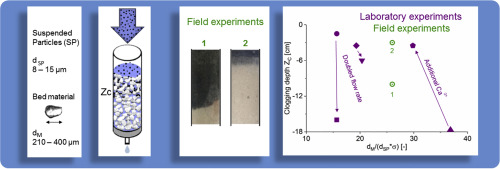当前位置:
X-MOL 学术
›
Water Res.
›
论文详情
Our official English website, www.x-mol.net, welcomes your
feedback! (Note: you will need to create a separate account there.)
Clogging of an Alpine streambed by silt-sized particles – Insights from laboratory and field experiments
Water Research ( IF 11.4 ) Pub Date : 2017-09-07 , DOI: 10.1016/j.watres.2017.09.015 Jasmin Fetzer , Markus Holzner , Michael Plötze , Gerhard Furrer
Water Research ( IF 11.4 ) Pub Date : 2017-09-07 , DOI: 10.1016/j.watres.2017.09.015 Jasmin Fetzer , Markus Holzner , Michael Plötze , Gerhard Furrer

|
Clogging of streambeds by suspended particles (SP) can cause environmental problems, as it can negatively influence, e.g., habitats for macrozoobenthos, fish reproduction and groundwater recharge. This especially applies in the case of silt-sized SP. Until now, most research has dealt with coarse SP and was carried out in laboratory systems. The aims of this study are to examine (1) whether physical clogging by silt-sized SP exhibits the same dynamics and patterns as by sand-sized SP, and (2) the comparability of results between laboratory and field experiments.We carried out vertical column experiments with sand-sized bed material and silt-sized SP, which are rich in mica minerals. In laboratory experiments, we investigated the degree of clogging quantified by the reduction of porosity and hydraulic conductivity and the maximum clogging depth as a function of size and shape of bed material, size of SP, pore water flow velocity, and concentration of calcium cations. The SP were collected from an Alpine sedimentation basin, where our field experiments were carried out. To investigate the clogging process in the field, we buried columns filled with sand-sized quartz in the stream bed.We found that the maximal bed-to-grain ratio where clogging still occurs is larger for silt-sized SP than for sand-sized SP. The observed clogging depths and the reduction of flow rate through the column from our laboratory experiments were comparable to those from the field. However, our field results showed that the extent of clogging strongly depends on the naturally-occurring hydrological dynamics. The field location was characterized by a more poly-disperse suspension, a strongly fluctuating water regime, and high SP concentrations at times, leading to more heterogeneous and more pronounced clogging when compared to laboratory results.
中文翻译:

淤泥状颗粒流淌的高山阻塞–来自实验室和现场实验的见解
悬浮颗粒(SP)堵塞河床会引起环境问题,因为它可能会对例如大型带状动物的栖息地,鱼类繁殖和地下水补给产生负面影响。这尤其适用于淤泥大小的SP。到现在为止,大多数研究都针对粗糙的SP,并且是在实验室系统中进行的。本研究的目的是检验(1)淤泥级SP的物理堵塞是否表现出与沙级SP相同的动力学和模式,以及(2)实验室与野外实验之间的可比性。使用富含云母矿物质的沙粒大小的床层材料和粉尘大小的SP进行的柱实验。在实验室实验中 我们研究了通过孔隙率和水力传导率的降低以及最大堵塞深度来量化的堵塞程度,该降低程度取决于床层材料的大小和形状,SP的大小,孔隙水流速和钙阳离子的浓度。SP是从一个高山沉积盆地收集的,在那里我们进行了实地实验。为了调查田间的堵塞过程,我们在河床中埋入了填充有沙子大小的石英的柱子,我们发现,淤泥大小的SP仍会发生堵塞的最大床粒比大于沙子大小的SP SP。从我们的实验室实验中观察到的堵塞深度和通过色谱柱的流速降低与现场的相当。然而,我们的现场结果表明,堵塞的程度在很大程度上取决于自然发生的水文动力学。与实验室结果相比,现场位置的特点是悬浮液分散性更高,水位波动剧烈,且SP浓度有时较高,导致异质性和堵塞现象更加明显。
更新日期:2017-09-07
中文翻译:

淤泥状颗粒流淌的高山阻塞–来自实验室和现场实验的见解
悬浮颗粒(SP)堵塞河床会引起环境问题,因为它可能会对例如大型带状动物的栖息地,鱼类繁殖和地下水补给产生负面影响。这尤其适用于淤泥大小的SP。到现在为止,大多数研究都针对粗糙的SP,并且是在实验室系统中进行的。本研究的目的是检验(1)淤泥级SP的物理堵塞是否表现出与沙级SP相同的动力学和模式,以及(2)实验室与野外实验之间的可比性。使用富含云母矿物质的沙粒大小的床层材料和粉尘大小的SP进行的柱实验。在实验室实验中 我们研究了通过孔隙率和水力传导率的降低以及最大堵塞深度来量化的堵塞程度,该降低程度取决于床层材料的大小和形状,SP的大小,孔隙水流速和钙阳离子的浓度。SP是从一个高山沉积盆地收集的,在那里我们进行了实地实验。为了调查田间的堵塞过程,我们在河床中埋入了填充有沙子大小的石英的柱子,我们发现,淤泥大小的SP仍会发生堵塞的最大床粒比大于沙子大小的SP SP。从我们的实验室实验中观察到的堵塞深度和通过色谱柱的流速降低与现场的相当。然而,我们的现场结果表明,堵塞的程度在很大程度上取决于自然发生的水文动力学。与实验室结果相比,现场位置的特点是悬浮液分散性更高,水位波动剧烈,且SP浓度有时较高,导致异质性和堵塞现象更加明显。











































 京公网安备 11010802027423号
京公网安备 11010802027423号